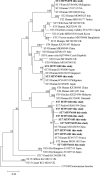Prevalence and molecular subtyping of Blastocystis in patients with Clostridium difficile infection, Singapore
- PMID: 34030712
- PMCID: PMC8142501
- DOI: 10.1186/s13071-021-04749-8
Prevalence and molecular subtyping of Blastocystis in patients with Clostridium difficile infection, Singapore
Abstract
Background: Blastocystis is a common anaerobic colonic protist in humans with controversial pathogenicity. Clostridium difficile (C. difficile) is the commonest cause of infectious diarrhea in healthcare settings. The prevalence and subtype (ST) characteristics of Blastocystis in patients with C. difficile infection (CDI) are rarely documented. Therefore, the present study was conducted to investigate the prevalence and subtype characteristics of Blastocystis in patients with suspicion of CDI in Singapore.
Methods: Fecal samples were collected from 248 patients presenting with suspected CDI from a single tertiary hospital in Singapore. C. difficile was diagnosed through positive glutamate dehydrogenase (GDH) with or without toxin A/B using enzyme immunoassay methods. The prevalence and subtype genetic characteristics of Blastocystis were determined by polymerase chain reaction (PCR) amplification and analysis of the barcode region of the SSU rRNA gene.
Results: The proportion of C. difficile in patients with healthcare-associated diarrhea in this study was 44% (109/248). Among the 109 C. difficile-positive patients, 59 (54.1%, 59/109) tested positive for toxigenic C. difficile, which was considered CDI. Based on the sequence analyses of the barcode region of the SSU rRNA gene, 10.1% (25/248) of the patients were found to be Blastocystis-positive, and three subtypes were identified: ST7 (64%, 16/25), ST1 (20%, 5/25), and ST3 (16%, 4/25). Remarkably, we found five patients with Blastocystis and C. difficile coinfection, and further subtype analysis showed two with ST7, two with ST1, and one with ST3.
Conclusions: To the best of our knowledge, this is the first study to investigate the subtype distributions of Blastocystis in patients with CDI in Singapore. We found ST7 to be the predominant subtype in diarrheal patients. The pathogenicity of ST7 has been strongly suggested in previous in vitro and mouse model experiments, further confirming its potential pathogenicity to humans.
Keywords: Blastocystis; Clostridium difficile; Diarrhea; Pathogenicity; ST7.
Conflict of interest statement
The authors declare that they have no competing interests.
Figures


Similar articles
-
[Genetic Diversity of Blastocystis in Diarrheal Cases: Identification of Subtypes and Alleles].Mikrobiyol Bul. 2024 Apr;58(2):196-208. doi: 10.5578/mb.202498207. Mikrobiyol Bul. 2024. PMID: 38676586 Turkish.
-
Molecular identification and subtyping of Blastocystis sp. in hospital patients in Central China.Eur J Protistol. 2021 Jun;79:125796. doi: 10.1016/j.ejop.2021.125796. Epub 2021 Apr 23. Eur J Protistol. 2021. PMID: 33975057
-
Molecular prevalence and subtype characteristics of Blastocystis among school children in Hainan, the tropical island province of China.Acta Trop. 2024 Oct;258:107353. doi: 10.1016/j.actatropica.2024.107353. Epub 2024 Aug 8. Acta Trop. 2024. PMID: 39122102
-
Epidemiology of Blastocystis sp. infection in China: a systematic review.Parasite. 2019;26:41. doi: 10.1051/parasite/2019042. Epub 2019 Jul 16. Parasite. 2019. PMID: 31309925 Free PMC article.
-
[Progress of researches on Blastocystis infections in humans and animals in China].Zhongguo Xue Xi Chong Bing Fang Zhi Za Zhi. 2020 Aug 6;33(1):95-101. doi: 10.16250/j.32.1374.2020101. Zhongguo Xue Xi Chong Bing Fang Zhi Za Zhi. 2020. PMID: 33660483 Review. Chinese.
Cited by
-
Interactions between Blastocystis subtype ST4 and gut microbiota in vitro.Parasit Vectors. 2022 Mar 8;15(1):80. doi: 10.1186/s13071-022-05194-x. Parasit Vectors. 2022. PMID: 35260166 Free PMC article.
-
Blastocystis and Giardia duodenalis infection in a male prison in Spain.Parasite Epidemiol Control. 2024 Dec 30;28:e00407. doi: 10.1016/j.parepi.2024.e00407. eCollection 2025 Feb. Parasite Epidemiol Control. 2024. PMID: 39886540 Free PMC article.
-
Decoding Blastocystis-Driven Mechanisms in Gut Microbiota and Host Metabolism.Adv Sci (Weinh). 2025 May;12(17):e2416325. doi: 10.1002/advs.202416325. Epub 2025 Apr 4. Adv Sci (Weinh). 2025. PMID: 40184630 Free PMC article. Review.
-
Gastrointestinal Pathogens in Multi-Infected Individuals: A Cluster Analysis of Interaction.Microorganisms. 2023 Oct 27;11(11):2642. doi: 10.3390/microorganisms11112642. Microorganisms. 2023. PMID: 38004654 Free PMC article.
-
Integrated Omics Reveal the Pathogenic Potential of Blastocystis sp. ST2.Transbound Emerg Dis. 2024 Mar 31;2024:6025236. doi: 10.1155/2024/6025236. eCollection 2024. Transbound Emerg Dis. 2024. PMID: 40303139 Free PMC article.
References
MeSH terms
Substances
Grants and funding
LinkOut - more resources
Full Text Sources
Other Literature Sources

